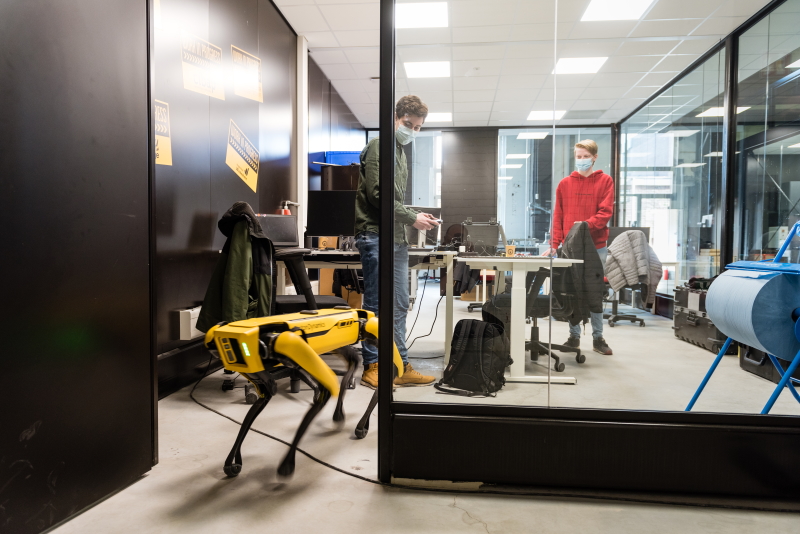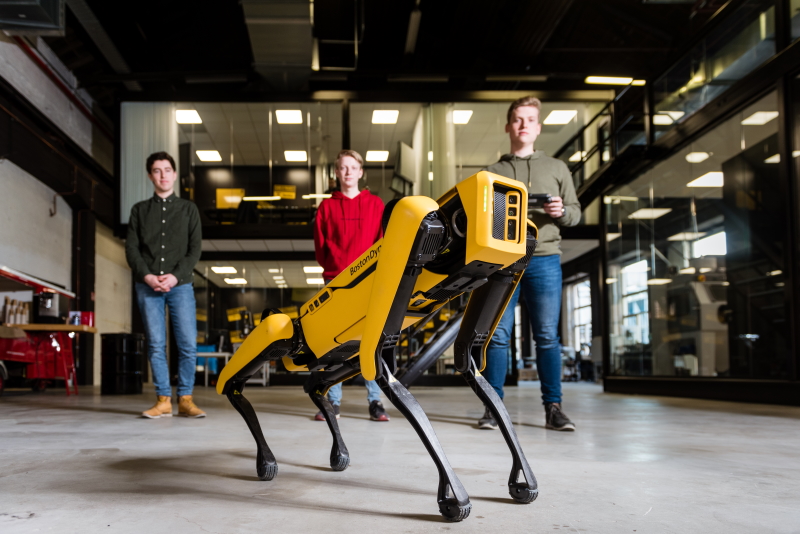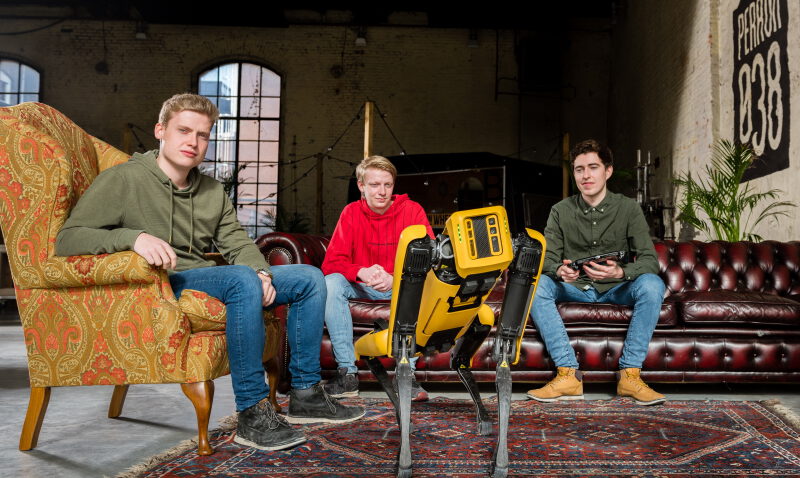Three Windesheim students received an exceptional opportunity: as the first students in The Netherlands, they can work with robot dog Spot. What can it do and how can it be used in a factory?
On its small legs Spot walks through the building. It walks up the stairs, sits down and even tilts its head like it’s looking at you. When it runs out of energy, it lies down. With a bit of fantasy, it’s just like a real dog. The difference: Spot isn’t made of flesh and bones, but of metal and complex technology. The three students from Windesheim research how the robot dog can be used.
“Spot is one-of-a-kind”, says third years student Electrical and Electronic Engineering Emiel. “We have never worked with something like this before; the fact that it has legs makes it much more complicated. It is a complex, but a very cool thing.”
They conduct their research in Perron038, a massive factory hall behind the train station in Zwolle, where several technical companies and students from different schools are located. Mechanical engineering company Tembo brought the robot to The Netherlands, asking Windesheim students to work with it. How much did Spot cost? 75,000 euro. “This is state-of-the-art technology”, says Windesheim teacher Freek Noordhuis. “The minor these students are doing is called “Factory of the future” and is a modern take on education. It’s less about the transfer of knowledge, so things are different than in other minors. The students, who come from different technical study programs, are mostly looking for knowledge and solutions independently. For them, it’s amazing to find out what you can do with Spot. Everyone thought the first iPhone was odd too and that also became a huge success. We are in the same initial stage with Spot. For a tech lover, this is an amazing opportunity.”
Tiny legs
Spot is different from other robots. Thanks to its small legs, small posture, and special functions it can reach places that people – and other robots – can’t. Teacher Freek: “It can walk in small areas, or on terrain wheeled robots can’t make it. Spot can also be used in noisy rooms or where they work with chemicals. It can avoid things, follow a certain route, walk upstairs… and you can place a camera on its back, to scan codes. Or you give it a robot arm and it can pick up and move things.
“You can look at Spot like an assistant in the work process. It can assist a service engineer in his work. A service engineer checks the machines in a factory to see if they’re still working as they should. In places the engineer can’t reach, Spot finishes the work. However, we haven’t entered that phase yet.”

From theory to practice
First, the students need to research how Spot can do that. Freek: “The students build the bridge from theory to practice. They analyse how Spot works, how it’s been programmed. Then they look for ways it can be used. It can’t climb every stair, but which ones can and can’t he climb? What happens when it bumps into something? How big can the obstacles be it can avoid? We know it has the functionality, but in reality, things often go a bit different.”
Not only are they looking at the possibilities of Spot, but they also want to make Spot be able to do it independently. “Using a controller is easy”, explains Tom, third years student Industrial Design Engineering. “But eventually it needs to do everything by itself. Otherwise, you’ll still need a person. So we write code and test if it does what we want it to. 9 out of 10 times it doesn’t do that right away.”
On its belly
In the future we expect Spot to be able to replace its own battery. To do that it will need help from another robot. Dinand, third years student Mechanical Engineering: “Spot can walk around for one and a half hour before it`s battery dies.
‘It can avoid obstacles, follow a route, climb stairs…’
We have to replace the battery ourselves right now, so we’re looking into ways it can do that by itself. For that, we use something we call a cobot: a robot arm. First, we build a recharging station, we are going to put that together soon.
At the recharging station, we’ll place the cobot. When Spot’s battery has almost died, it should go to the recharging station and lie on its back. The cobot removes the old battery from Spot’s belly, replaces it with a fully charged one and recharges the empty battery. This way Spot can walk around 24 hours a day.”
“It’s incredibly special,” concludes Dinand. “Not only working with Spot, but the fact that we can do that at Perron038 as well. In this building, you’ll find robots and cobots everywhere and we can try them all out. Very exciting, because I want to work with robots in the future.”

From left to right: Dinand, Emiel, Tom
Text: Silke Polhuijs
Pictures: Gerben Rink
